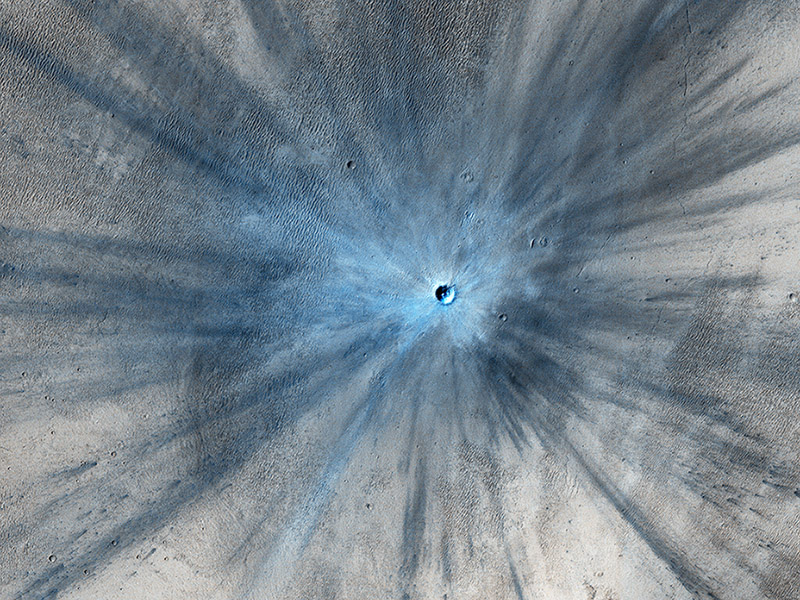NASA/JPL-Caltech/Univ. of Arizona
Posted on 02/15/2014 9:14:42 AM PST by SunkenCiv
A dramatic, fresh impact crater dominates this image taken by the High Resolution Imaging Science Experiment (HiRISE) camera on NASA's Mars Reconnaissance Orbiter on Nov. 19, 2013. Researchers used HiRISE to examine this site because the orbiter's Context Camera had revealed a change in appearance here between observations in July 2010 and May 2012, bracketing the formation of the crater between those observations.
The crater spans approximately 100 feet (30 meters) in diameter and is surrounded by a large, rayed blast zone. Because the terrain where the crater formed is dusty, the fresh crater appears blue in the enhanced color of the image, due to removal of the reddish dust in that area. Debris tossed outward during the formation of the crater is called ejecta. In examining ejecta's distribution, scientists can learn more about the impact event. The explosion that excavated this crater threw ejecta as far as 9.3 miles (15 kilometers).
The crater is at 3.7 degrees north latitude, 53.4 degrees east longitude on Mars. Before-and-after imaging that brackets appearance dates of fresh craters on Mars has indicated that impacts producing craters at least 12.8 feet (3.9 meters) in diameter occur at a rate exceeding 200 per year globally. Few of the scars are as dramatic in appearance as this one.
This image is one product from the HiRISE observation catalogued as ESP_034285_1835. Other products from the same observation are available at http://uahirise.org/ESP_034285_1835.
HiRISE is one of six instruments on NASA's Mars Reconnaissance Orbiter. The University of Arizona, Tucson, operates HiRISE, which was built by Ball Aerospace & Technologies Corp., Boulder, Colo. NASA's Jet Propulsion Laboratory, a division of the California Institute of Technology in Pasadena, manages the Mars Reconnaissance Orbiter and Mars Science Laboratory projects for NASA's Science Mission Directorate, Washington.
(Excerpt) Read more at jpl.nasa.gov ...
Thanks InABunkerUnderSF, looks like a ‘miss’ during interplanetary paintball! Extra to APoD.
I love Mars, by far my favorite planet. Its unusual moons, even remotely friendly atmosphere, and the mythology surrounding it all make it a star in the celebrity sense.
This impact crater is just another beauty mark.
/johnny
When the crater was created women and minorities were hardest hit...
Or mecca.
Its a harsh place but definitely “earthlike” in a wide scientific sense.
/johnny
Great image. Thanks.
|
Remember when it used to be red ?
 w0w...
w0w...
Pretty awesome!! Thanks!



With 200 x 4 meter rocks an year hitting somewhere on the planet, living in pressurized domes on the surface might be a little dicey. :-)
Even back in 1966, Heinlein envisioned that extraterrestrial colonies would need to be underground for that very reason.


Disclaimer: Opinions posted on Free Republic are those of the individual posters and do not necessarily represent the opinion of Free Republic or its management. All materials posted herein are protected by copyright law and the exemption for fair use of copyrighted works.